- Live In The D
- Newsletters

The secret city beneath our feet: Inside Detroit’s epic salt mines
The history of the detroit salt mines.
Morgan Russ , Digital News Editor
DETROIT – If the residents of Detroit ever tried to dig a hole to China like I did when I was a kid, you probably wouldn’t have made it to China, but you might have eventually reached the secret salty city below the streets of Detroit.
ClickOnDetroit readers frequently submit questions about the salt mines through our 4YI form , so we decided to take a deep dive into the epic salt mines below our feet.
Recommended Videos
According to the Detroit Salt Company , 400 million years ago, ocean water flooded into a large basin, an area known as the Michigan Basin. As the water evaporated it left behind large deposits of salt. These deposits were covered by dirt that was pushed by glaciers over the years. All of you sciencey folks out there, the Salt Company says this: “The basin was an arid area of Michigan’s lower peninsula separated from the ocean by a natural bar of land. As the basin continued to sink lower into the earth, salt-laden ocean water repeatedly poured into the depression, where it gradually evaporated, forming miles of salt beds.”
Related: Giant whipped cream cans in Dearborn: The history and where they are now
The salt rock was first discovered in 1895. The only issue is that the deposits were located beneath hundreds of feet of stone and glacial drift. By 1906, the Detroit Salt and Manufacturing Company was ready to do, what seemed to be, the impossible.
Construction crews had consistent challenges come their way. Aside from the stone and glacial drift, there was also the presence of hydrogen sulfide gas. Six men were killed during the dig. This endeavor would ultimately bankrupt Detroit Salt and Manufacturing Company before reaching the buried treasure.
Detroit Salt reports that the company was eventually reorganized and able to finish the 1,060-foot shaft in 1911 with their new name, Detroit Salt Company. Two years later, with new management, the Watkins Salt Company, the company was able to sink the shaft another 100 ft. and miners were able to begin work on a second salt bed.
Productivity significantly improved, so much so that their competitor International Salt Company began to notice their success. To maintain their hold on the Midwest, the company strategically purchased the Detroit mine.
Related: It’s no myth: The story of the elephant buried at former Waterford mall
By 1914, the mine was producing 8,000 tons of rock salt each month. The salt produced was mostly used for leather and food processing industries. New technology only pushed the mine further as physical demands of miners were reduced. More mine workers, more money, electric locomotives, mechanical shovels, and electric power were the keys to continued success.
In 1922, Detroit Salt explains, the company began to dig a deeper and larger second shaft. The goal was to increase the rate of hoisting rock salt to the surface. Within three years the second shaft was in operation. Due to narrow shaft openings, all of the machinery had to be lowered down piece by piece and reassembled once inside.
The mine remained in use until 1983, when International Salt closed the doors. Two years after the closure in 1985, Crystal Mines Inc. purchased the mine as a potential storage site. However, in 1997, the Detroit Salt Company, LLC, bought the mine back from Crystal Mines and began salt production in the fall of 1998.
Related: What happened to the big stove next to entrance of State Fair in Detroit?
Although the salt was used in leather production and food industries, road salt is currently the only product the mine provides.
In 2010, The Kissner Group purchased the Detroit Salt Company, LLC and the Detroit Mine, Detroit Salt says. Both companies now work together to provide the continent with a line of ice-melting products.
With the latest mining techniques, the mine is one of the safest, modern, and efficient mines in the world.
While many remember touring the salt mines decades ago, they are no longer available due to safety regulations. Try not to be salty about it.
Fun fact: the Detroit salt mines are featured and can be viewed in MINILAND Detroit, a Lego display with replicas of loved landmarks from Detroit at Legoland Discovery Center in Great Lakes Crossing.
Do you have a memory of touring the salt mines? Let us know in the comments below.
Copyright 2023 by WDIV ClickOnDetroit - All rights reserved.
Click here to take a moment and familiarize yourself with our Community Guidelines.
Detroit's salt mine: City beneath the city


Detroit Salt Mines
Introduction.
Text-to-speech Audio
Detroit Salt Mine Formation
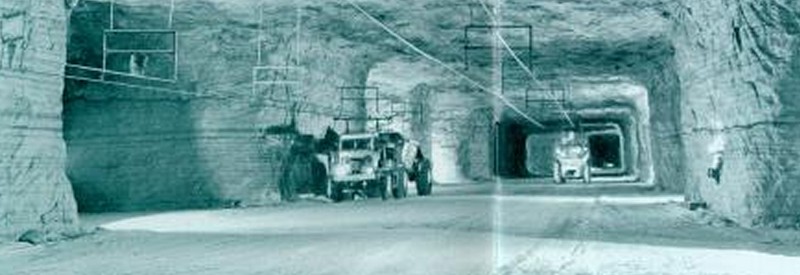
The shafts leading into the mines. Reuther Library/Tony Spina
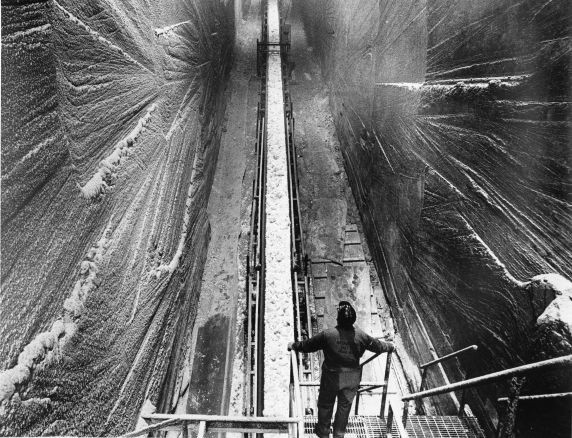
Large salt rocks within the mine
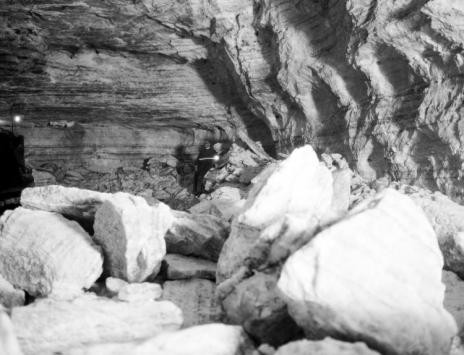
Mine employees
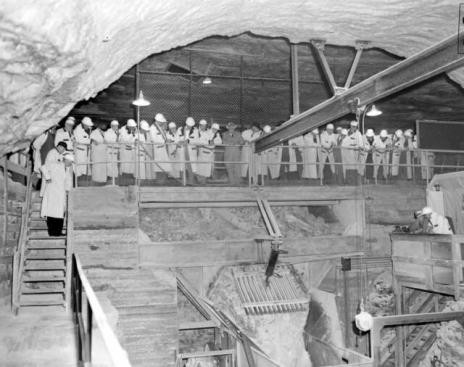
Backstory and Context
Creation of salt underneath the city of detroit.
The salt deposits underneath Detroit, spreading from north of Allen Park, underneath Dearborn’s Rouge, and covering most of Melvindale, were formed nearly 400 million years ago during the Devonian Period. It was a time when the first fish were evolving to grow legs to make their way onto land; the first seed bearing plants were coming into existence. Also, the area known as the Michigan Basin was separated from the ocean, and it was sinking lower and lower into the Earth’s crust. Salt water poured into the Basin, gradually over many years, until the oceans receded. The saltwater soon evaporated, leaving behind huge salt deposits.
Glacial activity led to the formation of the Niagara Escarpment, a large basalt rock area covering most of Wisconsin and Michigan, burying the salt deposits. The Great Lakes sit atop the basalt rock, and below, nearly 1,200 feet, the salt deposits remain as the largest known salt deposit in the world with over an estimated 71 trillion tons of unmined salt. 1
History of Salt Mining in Detroit
Native American tribes were historically known to filter and gather salt in the Detroit area from the various salt springs, but the first official discovery of the enormous salt deposits is credited to the year 1895. Despite the discovery, however, the salt deposits were over a thousand feet beneath stone and glacial drift, and getting to the salt turned out to be a deadly endeavor, with six men dying during the dig. The Detroit Salt and Manufacturing Company, the first to try and capitalize on the deposits, went bankrupt in the process.
By 1910, after the construction of a 1,060-foot shaft, extraction of the salt finally began. Objects lowered into the mines were destined to stay there forever, including the mules used to carry the extract salt. Four years later, under ownership of the International Salt Company, the Detroit mine was producing nearly 8,000 tons a month, and with the help of electric locomotives, mechanical shovels, and electric power, productivity was booming.
Then in 1922, to meet growing demand, International Salt dug a second shaft to accommodate greater manpower and machinery, and most of the machinery used at that time is still in the mines today. Salt mining continued until 1983, when International Salt closed the mines. In 1997, Detroit Salt Company LLC bought the mines and began mining once again for the road salt industry.
Today, the Kissner Group owns the mines, which now span over 1,500 acres with 100 miles of tunnels beneath Detroit, and the mine is considered to be the safest, most efficient in the world. 2
Additional Information
- Detroit Salt Co. Official Website
- "The vast, abandoned salt mines that lurk beneath Detroit," published by i09
- Time Magazine article on the mines

- New Releases
- Author News
- Our Bloggers
Wednesday, June 10, 2015
The detroit rock salt mine, the history of the detroit rock salt mines..
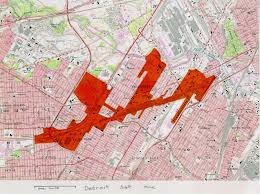
Interesting post. I do not know anything under the city of San Diego, but we are going to Seattle this week for vacation and hope to tour the underground city there under the HistoricTown area. sm wileygreen1(at)yahoo(dot)com
- Restaurants
- Development
- The Way It Was
- Film & TV
- Things to Do
- Fitness & Wellness
- Hour Media Events
- Partner Events
- Photography Request Form
- Best of Detroit
- Excellence in Care
- Faces of Detroit
- Top Docs Event
- Give Detroit
- Great Places
- Canna-Business
- Women Who Move Detroit
- Parents’ Guide to College
- Professionals
- Other Publications
- Digital Edition
- Purchase Single Issues
- Newsletters
- Where to Find

Detroit’s Salt Mine

1923 If you doubt that metro detroiters are “the salt of the earth,” just look down — about 1,200 feet. In the city’s cellar are more than 1,400 acres of a salt mine, remnants of what was a sea millions of years ago. The men wearing headlamps here are using pickaxes to hack at salt rocks. The mineshaft’s opening is on Sanders Street on the west side of Detroit, and the maze runs beneath Dearborn’s Rouge complex, Melvindale, and Allen Park. Opened in 1896, the mine was operated for years by the International Salt Mine Co. until 1983, when it closed. But the mine reopened in 1997, when the Detroit Salt Co. assumed ownership, supplying Michigan and other states with rock salt to melt hazardous ice on winter roadways. In 1940, Detroit became the first major city to use rock salt to control snow and ice.
RELATED ARTICLES MORE FROM AUTHOR

New “Hollywood-Style” Detroit Sign Cultivates Mixed Reviews

Detroit Photographer Vuhlandes Diagnosed With Leukemia

Parents of Oxford Shooter Sentenced to 10-15 Years
Newsletters.

FROM OUR PARTNERS

The War Memorial Celebrates Their 75th Anniversary with Annual...
Top 4 Wedding Venues in Detroit, Michigan – Presented...

Unveiling Ferndale’s Premier Cannabis Haven: Nature’s Remedy
- Terms & Conditions
- Privacy & Cookies Policy
- Grand Rapids/Muskegon
- Saginaw/Bay City
- All Michigan
Detroit's salt mines are Michigan's biggest buried secret
- Published: Jul. 28, 2017, 1:00 p.m.
- John Serba | [email protected]

The Detroit Salt Company (MLive photo | Ben Solis)
By John Serba | [email protected]
It’s called “the city beneath the city”: the myriad tunnels and chambers of the Detroit salt mines comprise one of our great state’s man-made marvels, a true thing of fascination for Michiganders. Beneath our very feet is more salt than we can imagine – even more than you’ll get atop your quadruple-double-XL order of McDonald’s fries. Way more.
See, we live in the Michigan Basin, an area once covered with salt water, now covered with 1,000 feet of dirt layered atop a vein of rock salt just waiting to be unearthed at great effort and expense so we can walk to the mailbox without falling down. Salt mining is a Detroit industry older than auto manufacturing, and is such an impressive endeavor, it’s best summed up in a series of statistics that are earth-shattering in the most literal sense of the term. Here are the Detroit salt mines, by the (really, really big) numbers.

The U.S. salt bed map (Courtesy photo | U.S. Dept. of Energy)
400 million
Age of the salt deposit, in years. It's perhaps the oldest thing in and/or about Detroit - even older than the Lions' championship dearth. Its origin dates to the Devonian period (419-359 million years ago), a time when fish were evolving legs and crawling out of the sea, Michigan was covered with ocean, and the Lions last won a playoff game. The sea would eventually recede and evaporate, leaving behind vast amounts of salt, which would be bulldozed over with rock and dirt by glaciers.
Years that have passed since the salt was discovered. Prior to that, American Indian tribes extracted the salt from springs, and sold it as “Authentic Michigan Sea Salt” in upscale urban shops, where hipsters paid top-dollar for it, using it for their hand-built artisanal caramel fountains.
Length, in feet, of the original mineshaft. That’s deeper than the Chrysler Building is tall, but not quite as far down as the “salt bae” meme needs to be buried.
Number of workers who died digging the shaf t. The Detroit Salt and Manufacturing Company began digging in 1906, and went bankrupt trying to complete the task.

Mackinac Bridge (MLive file photo)
Year the shaft was finally completed, by the Detroit Salt Company. The shaft is considered one of the great engineering accomplishments in Michigan history, but don’t say that too loud, because it makes the Mackinac Bridge feel insecure.
Size, in feet, of the opening to the shaft at the time . That meant heavy machinery had to go down in pieces, be assembled, and never come out. Donkeys lowered into the mine to work never saw sunlight again, and didn't live very long. "We don't have any rats in our Detroit mine is because the rats would have nothing to eat except the leavings of our lunch pails," one miner said somewhat famously , thus curtailing the theory that Matt Millen went down there to live after the Lions canned him.
Year digging of a second shaft began. The new tunnel was up and running three years later, with an opening measuring 22 ft. wide .
Amount, in tons, of salt yielded from a single dynamite blast . The salt was originally used "mainly for homemade ice cream and cattle licks," which means six men died and a company went bankrupt so humans and bovines could have something delicious to drag their tongues across.
Years the salt mine was abandoned, from 1983-1998. The economy of salt mining dried up like a 400 million-year-old ocean, prompting the company at the time, International Salt, to say, “Na.” Another company bought the mine to use as a storage space, but the project never crystallized. When it all shook out, the Detroit Salt Co. purchased the mine in 1997 and started business up again.
71 trillion
Approximate amount of salt, in tons, remaining down there, even after 100 years of mining. Detroit Salt produces 1.7 million tons of salt annually, and will increase to 2.5 million tons if a proposed expansion is approved . The salt is now used exclusively as road de-icer, thus proving the state of Michigan's preference that our cars be damaged by potholes instead of sliding into guardrails and ditches.
Acreage of the vast network of underground tunnels. Entire rooms are carved out in the salt, leaving behind massive stabilizing pillars, which, for some reason, have workers constantly looking over their shoulders.

MLive file photo | Rachel Sonnenshine
Miles of roads in the tunnels, which stretch from Dearborn to Allen Park. Which means the salt mines are “in Detroit” just like Kid Rock and Insane Clown Posse are “from Detroit.”
Tours of the mine currently being offered. Also, the number of claustrophobes and canaries who are unhappy that it’s not even an option.

MLive file photo
More Michigan life and culture
The 5 most ridiculous things about Michigan's state flag
12 wild and weird facts about the largest fish you can catch in the Great Lakes
The historic futility of the Detroit Lions: a very sad timeline
8 fascinating facts about Iron Mountain, Tom Izzo's hometown
Torch Lake is Michigan's own slice of the Caribbean
A guide to the 9 drive-in movie theaters still standing in Michigan
This Northern Michigan drive-in movie theater is a nostalgia trip
6 places to sip a Michigan beer along the White Pine Trail
These three Hollywood movies filmed at the same Niles train station
Use of and/or registration on any portion of this site constitutes acceptance of our User Agreement (updated 4/18/2024), Privacy Policy and Cookie Statement , and Your Privacy Choices and Rights (updated 12/31/2023).
© 2024 Advance Local Media LLC. All rights reserved ( About Us ). The material on this site may not be reproduced, distributed, transmitted, cached or otherwise used, except with the prior written permission of Advance Local.
Community Rules apply to all content you upload or otherwise submit to this site.
YouTube’s privacy policy is available here and YouTube’s terms of service is available here .
Copyright © 2010 International Ship Masters' Association Detroit Lodge No. 7, Inc. All Rights Reserved
Detroit Salt Mine: The hidden gem beneath our city.
By: metro detroit chevy dealers | october 8, 2012.

I’ve always been fascinated with salt. Laugh away, but it has an incredible history! Civilizations expanded and progressed in the quest for this amazing spice. Opposing militaries used it as a weapon of war, salting the fields to spoil land for crops. In ancient China, they used salt as currency. There isn’t a point in time when salt wasn’t important.
This is why it’s so exciting to me that Detroit has a massive working salt mine that stretches 1,500 acres from Dearborn to Allen Park . The mine shaft itself is 1,160 feet straight down and there are more than 100 miles of roads connecting the different areas of the mines. It’s an entire city beneath a city!
Rock salt was discovered in Detroit in 1895, but it wasn’t until 1906 that the Detroit Salt and Manufacturing Company began the arduous task of digging a shaft to create a mine. Despite many challenges, a bankruptcy and business reorganization, the shaft was completed by the newly named Detroit Salt Company.
In 1912, under the name Detroit Rock Salt Company, crews began work on a second salt bed. The new operation improved productivity and rock salt purity, which caught the eye of the International Salt Company who acquired Detroit Rock Salt in order to keep their edge on the marketplace. By 1914, crews began to utilize “modern” technology in the form of electric power, mechanical shovels and electric trains to help keep up with production needs, to the point that it was producing up to 8,000 tons of rock salt each month.
When you have the tools to do it yourself, nothing can stop you from turning your vision into reality. Trailblazer offers advanced storage options for a small SUV that is versatile, powerful, and ready to get the job done
With the demand for salt steadily increasing, the company recognized a need for a larger, second shaft and began to dig in 1922. By 1925, crews had completed the work and began using it to haul more rock salt to the surface. Crews continued to mine the rock salt until 1983 when production costs began to exceed salt prices, and International Salt halted operations. In 1997, Detroit Salt Company purchased the mine and began production again, which continues to this day.
And while it’s awesome to think that this mine has been operating virtually non-stop for the past 100 years, without fatalities or a collapse, there are other facts about the mine that are even more mind-blowing!
For as large as the mine is, you can imagine that the equipment needed to blast the salt and haul it around needs to be just as large. And getting it down those narrow shafts isn’t an easy feat. Typically, the equipment like trucks, machinery and jeeps, are disassembled, lowered down piece by piece and reassembled in the mine’s shop area. Then, once down in the mine, it stays there.
Another interesting fact is that if the mine shaft were a building, it would be second only to the Empire State Building which is 1260 feet tall, compared to the shaft’s “measly” 1160 feet. And, thanks to the depth, the temperature stays about 60 degrees year round. Perfect weather, if you can get over the fact there’s no sun.
But the greatest thing I find about the salt mine is the fact that you’d never know how big the mine is or how much goes on under our feet on a daily basis just by looking at the entrance to the mine. It’s sort of a metaphor for Detroit, isn’t it? There’s more to us going on than you think. Don’t take our city at face value. Sometimes you gotta dig a little deeper to get to the stuff that matters. And in this case, it’s salt.
To see some really great images, The Detroit News has an incredible archive of images from the mines first days, as does Environmental Graffiti.

RELATED STORIES

Snoopy Spectacular: A Must-See Collection In Metro Detroit

May Days To Remember: Top Events This Month

A Day With Your Adventure Partner: The Chevy Silverado

Want EXCLUSIVE In The D content?
Subscribe to our newsletter..

SIGNUP FOR A RELATED STORY!
- The Inventory
The vast, abandoned salt mines that lurk beneath Detroit
Over 1,000 feet beneath the city of Detroit is a 1,500 acre sprawl of tunnels created by salt miners at the turn of the twentieth century. Over at Environmental Graffiti, there's a fascinating story about the rise and fall of Detroit as the great city of salt production. Discovered in the late nineteenth century, Detroit's salt deposits would prove lucrative — but only to the company with the engineering capabilities to actually drill down far enough to reach it.
Related Content
As Environmental Graffiti's Simone Preuss explains:
The Detroit Salt and Manufacturing Company operated the mine until 1983 but then falling salt prices forced the mine to stop production. In its heyday in the 1920s, 1940s and ‘50s, the mine was open to the public with guided tours – a popular educational trip for school classes. Today, the entrance to the mine at 12841 Sanders Street is only for delivery trucks and public tours have not been conducted since the 1980s.
One of the many problems with working in such a deep mine was that equipment had to be lowered down the narrow shaft in pieces, then assembled at the bottom. Even donkeys were lowered down to work, and never brought back up.
Out of commission for many years, the mine was bought in the late 1990s and is now used mostly to produce rock salt. Here's hoping the new owners, Detroit Salt, will open it for tours again.
Read more, and see more pictures, at Environmental Graffiti
Images via Wayne State, Detroit Salt, and University of Michigan
Detroit's abandoned tunnel systems open door to another world
Below Detroit's streets is a network of tunnel systems almost as elaborate as the bustling metropolis that sits above it.
Unveiling this underworld opens a cavern of secrets necessary to understanding Detroit's history. While most of the tunnels are now abandoned and closed off to the public, learning about these labyrinths can contextualize the city's importance on the national level.
From the salt mines used to launch the city into economic prosperity at the start of the 20th century to the remnants of hidden caverns used to store liquor during America's Prohibition, explore what lies below:
Pedestrian walkways
Around 100 years ago, the popularity of automobiles resulted in a historic spike in pedestrian deaths . Detroit’s Highland Park neighborhood, which housed close to 50,000 residents in the early 1920s, reported a historic spike in pedestrian fatalities in 1924.
The solution was to build an underground tunnel to direct all pedestrian traffic, similar to the style of underground walkways seen in London and Canada. Three more tunnels were built at the Highland Park intersection in 1925, including one in Midtown at Cass Avenue and Peterboro Street, though no physical remnants of the latter site remain today.
Documented by TikTok user @Colin313 in July 2022, Highland Park’s raised cement underpass can be seen at the corner of Cortland and Second Avenue.
Rock salt was discovered below the depths of Michigan’s streets in 1895, and almost immediately, the horizontal salt beds were mined for the resource’s rich currency.
By 1906, Detroit established the Detroit Rock Salt Co. to develop a safe, effective way to mine the salt. It took years of configuration before a 1,060-foot shaft was dug into the city’s core and by 1914, Detroit was exporting 8,000 tons of rock salt each month.
The mines remained operational until 1984 and reopened after a brief hiatus in 1983 to provide the road salt used by the city today. Road salt is the only form of salt currently produced by the mines, and tours were provided briefly in the mid-1980s but are now suspended because of ongoing production.
More: A look inside Wayne County's salt distribution process each winter
Tunnels at Detroit's Fisher Building
Detroit’s Fisher Building was constructed in 1927 by the Fisher brothers, whose Fisher Body Co. was responsible for the closed-body chassis of the 1910 Cadillac and introducing the first four-door sedan bodies.
This immense success in reimagining the automobile industry motivated the brothers to purchase 32 parcels along West Grand Boulevard to “serve as an expressive testimonial of the Fishers’ activity in Detroit.”
The art deco, 441-foot building is flanked by two 11-story, flat-roofed wings and is topped with a glowing green spear.
Below ground, an elaborate tunnel system connected the Fisher to New Center and General Motors buildings to ease employee commute.
The tunnels are open today, though all of the once bustling storefronts are now shuttered.
More: 10 fascinating facts about Detroit's Fisher Building
Detroit Medical Center tunnels
Adjacent to Wayne State University’s campus in Midtown, the Detroit Medical Center holds eight hospitals in a one-block area surrounded by John R, Mack, St. Antoine and East Canfield Street. A tunnel system connects each of the hospitals making safe, seamless travel for patients and medical employees alike.
Prohibition-era tunnels
A little over 100 years ago, Detroit stood as the first major U.S. city to instate Prohibition , a complete criminalization of alcohol and those who distribute and consume it, which lasted more than a decade before being repealed in 1933.
Almost as quickly as the law was enacted, underground smuggling and speakeasies began to appear, with some experts estimating Detroit’s river crossing to Canada was responsible for 75% of alcohol flowing into the U.S. during Prohibition.
Tommy’s Bar on Third Avenue was formerly owned by businessmen affiliated with the city’s notorious Purple Gang, and a WSU-sponsored archaeological dig in 2013 unearthed an underground speakeasy and tunneling system leading to a false room below the bar.
Utility tunnels
Installed in the early 1950s, utility tunnels below Detroit’s Midtown and downtown streets carry the water and steam necessary to fuel the area.
A network of steam tunnels and pipes dates to 1903 and is used to heat buildings throughout the city today. Reaching 60 feet below the street surface and opening into a 10-foot by 10-foot well, the tunnels stretch for miles .
The steam loops ran on coal until converting into natural gas in the 1970s, and Detroit’s incinerator became its main source by 1986.
The steam is also used to cook hot dogs at Lafayette Coney Island and brew beer at Detroit Beer Co.
Beyond the city ...
Detroit metropolitan airport's light tunnel.
A tunnel of psychedelic lights connects Detroit Metropolitan Airport’s A and B/C Councourses to an original soundtrack.
Located in McNamara Terminal, the Light Tunnel is nearly 800 feet long and illuminated by 9,000 feet of glass panels and LED lighting — as a moving walkway carries passengers through the tunnel.
For those with light or noise sensitivity, a “suspend button” at the end of each tunnel pauses the light and music show for 15 minutes.
Northland Center’s underground tunnels
Below the halls of the former Northland Center in Southfield is a miles-long labyrinth of tunnels , with an astonishing 484 rooms, dating to 1954. The tunnels were used primarily for truck deliveries to and from Northland’s stores and also included storage space and nuclear bomb shelters.
The unique system of service tunnels set a precedent for surrounding shopping centers, although they were off-limits to the public and remained closed and unpassable after the mall's closure in 2015. The tunnels were likely buried during the mall’s demolition in 2021, leaving behind a treasure trove of arcade games and mannequin torsos.
Detroit Salt Mine Entrance, Michigan
Salt has been mined from underneath Detroit for more than a century. Most of the mine is located underneath the Dearborn and River Rouge area, where around 100 miles of roads and 1,500 acres of excavated space lie 1,200 feet below the surface. The room and pillar method is still used here, using explosives to blast out the salt, which travels by conveyors underground to the shaft which brings it more than 1,000 feet up vertically in ten ton loads to the surface. The salt is used as winter road salt.
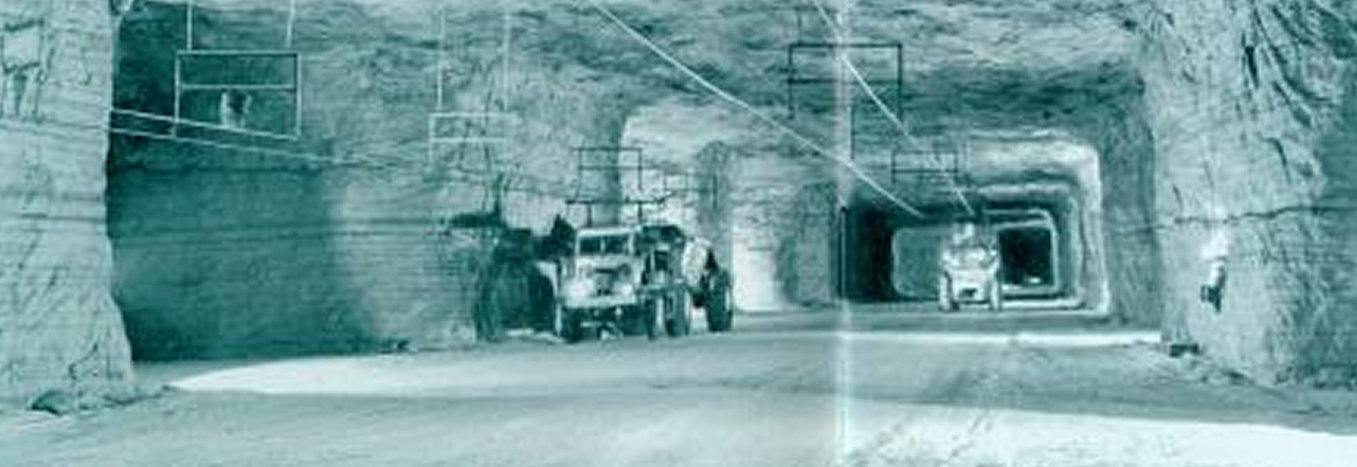
Detroit Salt Mine Formation
How did the salt get there in the first place?
Michigan, in geologic terms, is a basin - a large area of lower elevation than surrounding areas. 400 million years ago, scientists believe this area was filled with salty sea water, much like the Great Salt Lake in Salt Lake City, Utah.
Through several climate changes, a process of layering began, leaving deposits of salt and other minerals behind in Michigan.
These salt deposits were covered with other sediments over several millions of years, forming alternating layers of rocks.
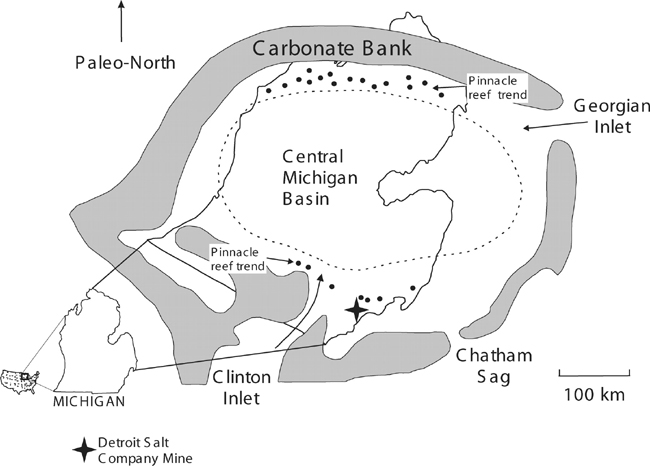
Detroit Salt Company
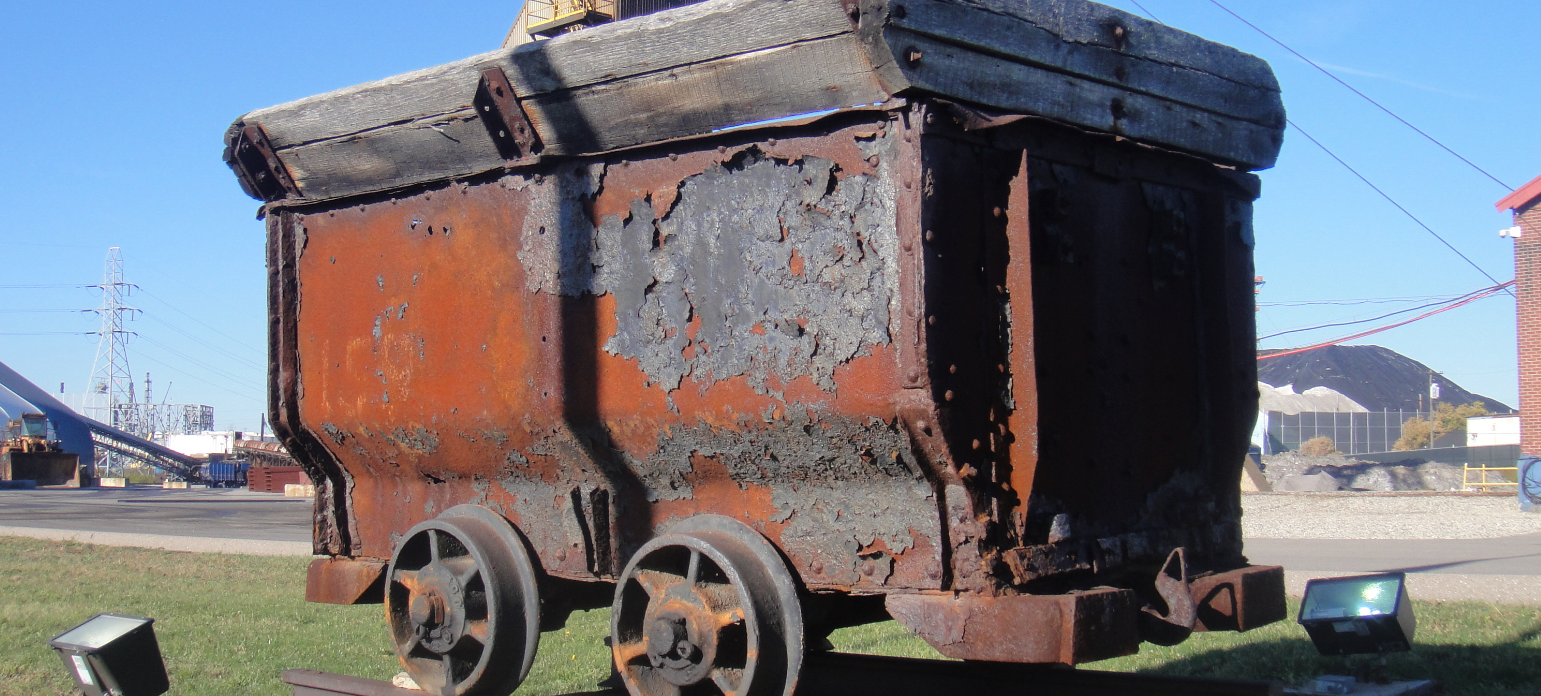

IMAGES
VIDEO
COMMENTS
Detroit salt mine worker (Detroit Salt Company) The mine remained in use until 1983, when International Salt closed the doors. Two years after the closure in 1985, Crystal Mines Inc. purchased the ...
Six men were killed during the dig, and the Detroit Salt and Manufacturing Company was bankrupted in the process. The 1,060-foot shaft was finally completed in 1910. A second tunnel was dug in ...
The existence of rock salt in the Detroit area was discovered in 1895, and the difficult and expensive work of digging a mine shaft began in 1906. The original company went bankrupt before any ...
Are you late for your tour? Did you know Detroit was the first city to assign individual phone numbers way back in 1879? ... 1,200 feet under Detroit is a huge, giant, insanely big salt mine. The mine sprawls across 1,500 acres and contains more than 100 miles of road.
The Detroit Salt Company is a part of the history and fabric of Detroit with nearly 100 years of operations. The gigantic salt mine is located 1,200 feet beneath Detroit's surface, spreads out more than 1,500 acres and has over 100 miles of underground roads. The mineshaft opening is located at 12841 Sanders Street in Detroit, Michigan.
Detroit salt mine. Coordinates: 42.2858°N 83.1497°W. The Detroit salt mine is a salt mine located 1,100 ft (340 m) below Detroit, Michigan. [1] The mine opened in 1910 and covers 1,500 acres (610 ha) underground. [2] In the beginning, the leather and food industries were the primary customers. Today, road deicing salt is the primary product. [3]
In 1997, the Detroit Salt Company, LLC, purchased the mine from Crystal Mines, Inc. and began salt production in the fall of 1998. Although the leather and food industries were once large customers to the Detroit mine, road deicing salt is the only product the mine currently provides. The Detroit Salt Company, LLC, employs the latest mining ...
While walking through downtown Detroit, visitors and tourists are rarely aware that beneath their feet lies a massive expanse of tunnels and, essentially, an underground metropolis spanning 1,500 acres with over 100 miles of roads. Known as one of the largest salt deposits and the most spectacular salt mines in the world, the Detroit salt mines are central to the city's economy and culture ...
A new company, Detroit Rock Salt Company, took over the excavation and completed the job in 1910. The struggle to complete the 1,060 shaft was one of the most impressive engineering feats of its time. By 1925, a competing salt mining company, International Salt, purchased the mine and a second, larger shaft, was dug.
January 24, 2011. 1923 If you doubt that metro detroiters are "the salt of the earth," just look down — about 1,200 feet. In the city's cellar are more than 1,400 acres of a salt mine, remnants of what was a sea millions of years ago. The men wearing headlamps here are using pickaxes to hack at salt rocks. The mineshaft's opening is ...
Years the salt mine was abandoned, from 1983-1998. The economy of salt mining dried up like a 400 million-year-old ocean, prompting the company at the time, International Salt, to say, "Na."
The Detroit Salt Company, LLC, has owned and operated Michigan's only rock salt mine since 1997. This privately held business was acquired by The Kissner Group in 2010 and is as rooted in southeast Michigan as the mine itself. ... The salt mine's 100+ year history with the city of Detroit encompasses decades of effort, manpower and ...
detroit's salt mines are michigan's biggest buried secret & you can't see it! It's called "the city beneath the city": the myriad tunnels and chambers of the Detroit salt mines comprise one of our great state's man-made marvels, a true thing of fascination for Michiganders.
Thanks to the generosity of the Detroit Salt Company, and the organizing efforts of Lodge No. 7 member Malcolm "Mac" McAdam, this group was given the rare opportunity to tour the mine of the Detroit Salt Company on Saturday, June 26, 2010. The tour also served as a fund-raiser for the ISMA Grand Lodge Scholarship Fund.
It's an entire city beneath a city! Rock salt was discovered in Detroit in 1895, but it wasn't until 1906 that the Detroit Salt and Manufacturing Company began the arduous task of digging a shaft to create a mine. Despite many challenges, a bankruptcy and business reorganization, the shaft was completed by the newly named Detroit Salt Company.
A couple of quick updates: A California holding company bought the salt mine's parent company for a reported $2 billion in 2020. The Detroit salt mine continues to provide much of the salt used on our roads. Wayne County has bought more than a million dollars' worth of salt from the mine this winter. Oakland County has spread more than ...
Over 1,000 feet beneath the city of Detroit is a 1,500 acre sprawl of tunnels created by salt miners at the turn of the twentieth century. Over at Environmental Graffiti, there's a fascinating ...
When did they start mining? In 1906, the Detroit Salt and Manufacturing Company began sinking a shaft, which was completed in 1911 when the current layer of salt that we mine in now was reached. Why did they start mining? Salt is a mineral that has many uses. In the late 1800's and early 1900's, today's refrigerators had not yet been perfected ...
Road salt is the only form of salt currently produced by the mines, and tours were provided briefly in the mid-1980s but are now suspended because of ongoing production. More: A look inside Wayne ...
Salt has been mined from underneath Detroit for more than a century. Most of the mine is located underneath the Dearborn and River Rouge area, where around 100 miles of roads and 1,500 acres of excavated space lie 1,200 feet below the surface. The room and pillar method is still used here, using explosives to blast out the salt, which travels by conveyors underground to the shaft which brings ...
Approximately 1,000 feet of rock lie atop the vein of salt. To safely extract the salt from the deep deposits, Detroit Salt Company employs the "room and pillar" system. This method creates massive pillars, which support the mine roof and the overburden separating the mine from the surface. Parallel galleries - or rooms - give the mine ...
Detroit Salt Mine Formation. How did the salt get there in the first place? Michigan, in geologic terms, is a basin - a large area of lower elevation than surrounding areas. 400 million years ago, scientists believe this area was filled with salty sea water, much like the Great Salt Lake in Salt Lake City, Utah. Through several climate changes ...